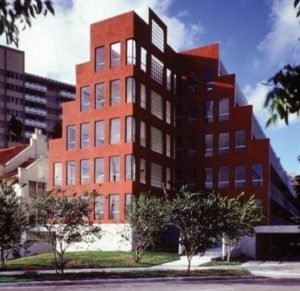This building put Arquitectonica on the global map. That won’t stop its demolition.
January 29, 2018It’s bye-bye Babylon.
Miami commissioners have signed a death warrant for the Babylon, the distinctly colorful, ziggurat-shaped Brickell apartment house that was the first commercial building by homegrown design giant Arquitectonica and a landmark that helped set the stage for the city’s downtown revival.
By a 4-1 vote and to plaintive boos from preservationists, commissioners overturned a 2016 decision by the city’s historic preservation board that declared the Babylon a protected architectural landmark, a designation strongly backed at the hearing by city preservation officer Warren Adams. The commission vote granted an appeal by the building’s owner, who had been trying for years to tear down the 1982 building and redevelop the sliver of land it occupies on Brickell Bay Drive.
The commission majority went against the express wishes of the district representative, Ken Russell, who argued the Babylon plainly meets multiple criteria for historic designation. Russell could not muster a second on his motion to deny the appeal.
Thursday’s vote likely ends a vigorous two-year battle by preservationists, architects and Brickell residents who collected 700 signatures on a petition to save the Babylon, today a low-rise anomaly hemmed in by massive towers. It clears the way for Babylon principal owner Francisco “Paco” Martinez Celeiro, a one-time spaghetti western star, to apply for a demolition permit for the vacant and deteriorated five-story building. The structure features an unusual stepped facade painted bright red and long balconies with rails like those on a cruise ship.
The building design won a major architectural award before it was even finished, setting then-unknown Arquitectonica on a path to global fame. It is widely credited with raising the bar for architectural design in once-dowdy downtown Miami.
Some neighbors and preservationists allege Martinez Celeiro allowed the building, which was declared an unsafe structure by the city in 2016, to slide into near-ruin. But the owner and his engineers contend the building leaks badly and is crumbling because it was poorly designed and cheaply built.
The city preservation board, which has the power to designate buildings and sites as historic, blocked demolition in 2016 just as Martinez Celeiro was about to obtain a permit to take the building down. Martinez Celeiro’s attorney, Jeffrey Bercow, said after Thursday’s hearing that his client plans to reapply for a demolition permit promptly.
The Babylon, designed in 1979 but not completed until three years later, falls well short of the normal eligibility standard of 50 years of age to qualify for historic designation under the city’s preservation ordinance. But the preservation board concluded that it possessed “extraordinary merit” for its design and its role in setting the template for the redevelopment of downtown Miami — a finding that allowed it to override the 50-year guideline. In doing so, it overruled an opinion by its previous preservation officer.
The board reached similar conclusions in recent years to protect the famed Bacardi complex on Biscayne Boulevard and the Miami Marine Stadium, both of which were under 50 years old when designated historic.
But Martinez Celeiro, his attorneys and architectural consultants argued that the Babylon’s design quality and historic significance does not come near that of the Marine Stadium or the Bacardi buildings, and even pales in comparison to a trio of Arquitectonica towers from the same period that radically redefined Brickell Avenue — including the Atlantis, the famed condo with a square hole and a palm tree in the middle.
“We love them and the work they do,” Bercow said of Arquitectonica. “But not every work of a master deserves to be designated.”
A neighbor confronted Bernardo Fort-Brescia, founder of the internationally recognized architecture firm Arquitectonica, about cutting protected mangroves following Hurricane Irma.
Miami-Dade County Division of Environmental Resources Management
The Babylon owner’s engineer, John Pepper, said it was so poorly built it was “corroded to pieces” and poses a public hazard.
Commission chairman Keon Hardeman said he found the engineering argument persuasive, though he acknowledged that many historic buildings are rundown. The condition of a building is not a criteria for designation under city law.
The commission debate also featured an unusual, long disquisition by Commissioner Joe Carollo on the history of drug dealing in Miami in the 1980s and the role of Cuban leader Raúl Castro in aiding trafficking, as well as the hit the city’s reputation took from the film “Scarface.” Carollo alleged the Babylon was built by drug dealers and murderers and should not be saved.
“This is the real history of the Babylon,” Carollo said. “This is a place built on the cheap by a guy who was so high he didn’t know if he was coming or going most of the time. I’m amazed that we’re talking about this 35 years later. I’m amazed we have spent too much time glorifying one of the worst buildings in an era many of us would like to forget.”
Commission newcomer Manolo Reyes also added a startling footnote to the debate, declaring he believes properties should be designated historic only with owners’ consent or if a famed historic figure was born there — a posture that puts him sharply at odds with the city’s own laws and broadly accepted, court-approved practices.
Like most such preservation regimes across the country, Miami’s preservation ordinance, a subset of its zoning code that’s patterned on federal guidelines that have survived decades of legal challenges, does not require owner consent. In fact, it allows preservation board members and representatives of preservation groups to nominate a property for designation. The board can then designate a property as historic if it concludes it meets certain criteria for architectural or historic importance.
The Babylon was Arquitectonica’s first building and only its second design, after the famed Pink House designed for co-founder Laurinda Spear’s parents in Miami Shores. Spear was primarily responsible for the Babylon, whose name was inspired by its ziggurat shape — itself a response to the narrow site and the need to set the building back from adjoining houses that have long since vanished. — Andres Viglucci












































